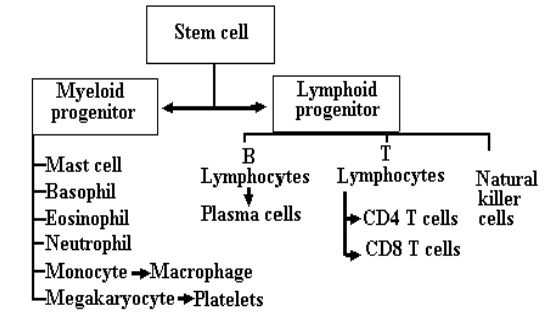Chapter: Microbiology
Cells of the Immune System
CELLS OF THE IMMUNE SYSTEM
Immune system consists of many organs and different cell types. The cells of the immune system develop from pluripotent stem cells from bone marrow. The haematopoieticstem cells give rise to red blood cells. White blood cells develop through two different pathways. The lymphoid lineage produces both T and B lymphocytes, and Natural killer (NK) cells. The myeloid lineage produces monocytes, macroph-ages, granulocytes basophils eosinophils, neutrophils, platelets and also mast cells.

Lymphocytes
T cells:
Origin:
All cells of lymphoid system arise from the pluripotent stem cells from the bone marrow
Maturation:
Maturation of T cells takes place in different stages. Thymus secretes a humoral factor that attracts the T cells to the thymus.
Stage I
Pro T cells or Early thymocytes
They are present in thymic cortex.
These are the earliest recognizable thymocytes. They contain cell differentiation molecules CD2 and CD7. CD3 proteins are present in the cytoplasm. Transferrin molecule is also present
Stage II
Intermediate or common thymocytes
These are present in thymic cortex. They constitute 85% of lym-phocytes at this stage. Additional markers like CD1,CD4 and CD8 are also present. They are called double positive cells because they contain both CD4 and CD8 markers. Genes coding for the α chain of TCR2 molecules are rearranged in these thymocytes
Stage III
Mature thymocytes.
This development takes place in thymic medulla. There is loss of CD1, CD 38 and transferrin molecules.
CD3 molecule is present on the cell membrane in association with TCR2 molecules. There is distinction of two cell markers CD4 and CD8. The T cells that possess CD4 are called CD4 T cells and the ones possessing CD8 are called CD8 T cells
Functional sub sets of T cells
Based on their functions the T cells are subdivided into the fol-lowing:
(1) T helper cell, (2) T suppressor cells, (3) T cytotoxic cells (4) T cells involved in delayed hypersensitivity (DTH) reaction
B cell development
Pre B cells to mature B cells
B cells like other blood cells arise from pluripotent haematopoietic stem cells. In embryogenesis, the first B cell lineage makes heavy chain but not light chain. More differentiated cells called pre B cells are detected in the fetal liver about half way through gestation. They ap-pear as large and small lymphocytes with cytoplasmic IgM without surface Immunoglobulin (Ig) molecules. Similar cells are seen in small numbers in adult bone marrow indicating that B cells continue to arise from stem cells throughout the life.
Immature B cells
Pre B cells give rise to immature B cells which have surface IgM (sIgM). They lack several other surface molecules.
Mature B cells
These arise from immature B cells. They contain two or more surface Ig isotypes along with sIgM.. They also have Fc receptors and complement receptors.
They are not easily made tolerant. In the terminal differentiation the mature B cells are stimulated by T dependent antigen to develop into plasma cells which secrete antibody molecules
Related Topics